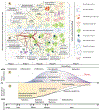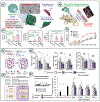Biomaterials to enhance stem cell transplantation
- PMID: 35483364
- PMCID: PMC10169090
- DOI: 10.1016/j.stem.2022.04.002
Biomaterials to enhance stem cell transplantation
Abstract
The successful transplantation of stem cells has the potential to transform regenerative medicine approaches and open promising avenues to repair, replace, and regenerate diseased, damaged, or aged tissues. However, pre-/post-transplantation issues of poor cell survival, retention, cell fate regulation, and insufficient integration with host tissues constitute significant challenges. The success of stem cell transplantation depends upon the coordinated sequence of stem cell renewal, specific lineage differentiation, assembly, and maintenance of long-term function. Advances in biomaterials can improve pre-/post-transplantation outcomes by integrating biophysiochemical cues and emulating tissue microenvironments. This review highlights leading biomaterials-based approaches for enhancing stem cell transplantation.
Copyright © 2022 Elsevier Inc. All rights reserved.
Conflict of interest statement
Declaration of interests The authors declare the following competing financial interest(s): T.A.D. is a scientific founder of Encellin, a cell therapy device company, and she is listed as an inventor of a macro-encapsulation technology (US Patent #10,865,378) described in this paper.
Figures





References
-
- Ahn CB, Lee J-H, Kim JH, Kim TH, Jun H-S, Son KH, and Lee JW (2022). Development of a 3D subcutaneous construct containing insulin-producing beta-cells using bioprinting. Bio-Des. Manuf 5, 265–276. 10.1007/S42242-021-00178-9/FIGURES/8. - DOI

